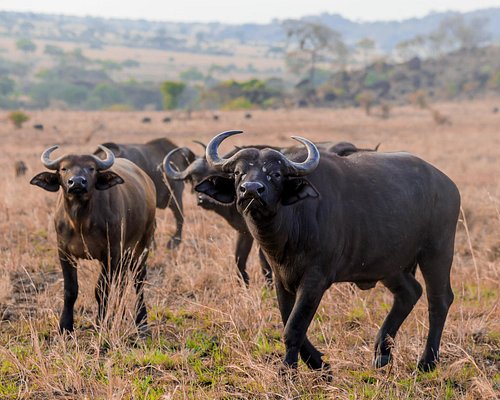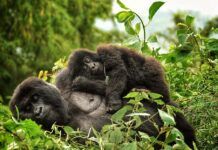Explore main highlights on this Tanzania safari including the Serengeti, Lake Manyara, Lake Natron, and the Ngorongoro Crater. From the incredible game of an Africa safari, to the unique tribal villages in the cradle of all mankind, Tanzania offers something for everyone! Visit a local Maasai community and learn about traditional tribal customs.
Hike in Mount Kilimanjaro National Park to spot the elusive tree climbing lion, and stay in comfortable mobile safari camps such as Serengeti Halisi and Pakulala Safari Camp.
Meet your Tanzania tour representative at the airport and transfer to the Kilimanjaro Halisi Retreat where you can rest before starting out on your exciting trip around Tanzania.
On a fresh day, start with a drive to the small village of Uru on the slopes of Kilimanjaro and visit the local coffee cooperative on an all-encompassing tour of the grounds. This guided tour displays how coffee is grown, harvested, and roasted and participants join in the entire process, including brewing their own cup of coffee!
Meet with local farmers while the women prepare a delicious lunch while you enjoy the amazing scenery. Head back to Moshi in the afternoon and enjoy the hotel or explore the city’s traditional markets independently.
Embark on Mount Kilimanjaro for a day hike! This dominant fixture to the Tanzanian landscape rises an impressive 5895 meters at its highest peak. Transfer to the Marangu Gate where you will commence your day hike. Walk through the lush rain forest rising 800 meters to Mandara Hut where you stop for a well-deserved picnic lunch. After your respite you will continue on to Maundi Crater before returning to the Marangu Gate and transferring back to Moshi.
After the hiking experience, drive to Tarangire national park. The better part of the day is spent on a game drive in the Tarangire National Park. The park is known for its enormous herds of elephants, ancient baobab trees, and having the greatest concentration of wildlife outside the Serengeti. During the dry season (June-Sept), animals flock from hundreds of miles to drink from the Tarangire River. Arrive at the Tarangire Safari Lodge in time for dinner.
On a new superb day, take an early safari through Tarangire National Park before the heat of the day limits the movement of the animals. After lunch head to the Rhotia Valley, your home for the next two nights. This evening enjoys a guided village walk and learn about the local customs and traditions.
You are also welcome to visit the Children’s Home, located adjacent to the lodge. The home is funded directly from the profits of the camp, and provides healthy food, clean water, clothing and education to the kids who stay there.
Rise early and meet your guide from the Mto Wa Mbu Cultural Tourism Program and walk to the shores of Lake Manyara, a shallow lake in the East Africa Rift. Flamingos flock to the lake in the wet season (August to October) for an impressive spectacle. Throughout the year travellers can expect to see leopards, lions, elephants, blue monkeys, dik-dik, gazelle, hippo, giraffe impala and more! Lake Manyara provides a rare opportunity for guests to see animals away from the confines of their vehicles.
Mto Wa Mbu is a small village where people of many different tribes, from every corner of the country, happily coexist. Here the Mbugwe, Iraqw, Gorowa, Irangi, Chaga and Maasai tribes’ area all represented. Tour a Chaga family farm where banana beer is brewed or visit a Kigoma farmer who presses palm oil.
If time permits, you can meet the Rangi people at Papyrus Lake and see them collect materials in order to make mats and baskets. En route, watch traditional rice farming and visit the Sandawe families who still make traditional bow and arrows for hunting.
After the amazing experience, descend into the Ngorongoro Crater for a six hour tour. As the world’s largest caldera (nearly 100 square miles), Ngorongoro boasts over 20,000 large animals, including Tanzania’s remaining black rhino. Living along-side the abundance of wildlife you will find 40,000 Maasai pastoralists with their cattle, goats, and sheep.
The conservation gives you a rare look into how people harmoniously lived with nature and wildlife in ancient times. You may also opt to visit Oldupai Gorge. This site provides evidence of the earliest signs of mankind, showcasing hominid footprints preserved in volcanic rock that date back 3.6 million years.
After everlasting memories in Ngorongoro, take a game drive en route to Serengeti National Park, a world heritage site, stopping along the way to watch any animals you may encounter. Renowned for its wealth of lions and leopards, the Serengeti is the quintessential safari destination. Derived from the Maasai word ‘sirinetu’ meaning ‘endless plains’, the Serengeti plays host to more than a million wildebeest, 200,000 zebra, and 300,000 Thomson’s gazelle during the annual migration.
While here, take an early morning game drive and return to camp in time for breakfast. Head back out for a full day of game drives, examining one of the oldest ecosystems on earth. Little has changed in the Serengeti over the past million or so years, you will still find the renowned plains intermingled with wooded hills, massive termite mounds, rocky kopjes, and acacia tree lined rivers. Depending on the time of year you will be able to witness the Wildebeest Migration (Dec-July), or an abundance of predators (June-Oct).
Head towards Lake Natron after breakfast, with a game drive en route. You never know what animals will reveal themselves when you are in the Serengeti. Lake Natron is a surreal soda lake below the Rift Valley escarpment, and millions of flamingos flock here, as it is their only breeding ground. Enjoy the views of Ol Dointo L’Engai, the only active carbonate Volcano in the world before heading to Lake Natron Halisi Camp for dinner.
Early morning, you will have time to take in the beauty of the lake before embarking on an afternoon walk to waterfalls in the area. There is also the option to stop by a local clinic or school on the way to the waterfall. The lake’s namesake is derived from the concentration of Sodium Carbonate (Natron) remaining in the shallow lake during times of high evaporation. Due to high temperature and the high and varying salt content of the lake, this area is not able to support wildlife, making it a safe place for birds to nest.
Transfer today to Lake Manyara, stopping along the way to witness Maasai culture and cows being milked at a Maasai Boma. Here you will learn about the fascinating culture, traditions, and history of the area and may also have the opportunity to visit a Maasai hut.
Settle in for one last evening in Tanzania at the Migunga Forest Camp. Don’t forget about the Tree climbing lions in Lake Manyara national park: Tree climbing lions are among the unique attractions that can be seen by tourists on safari in Lake Manyara national park which is located in the northern part of Tanzania and in the south western direction from Arusha. After all the above, transfer back to the airport for your flight.






